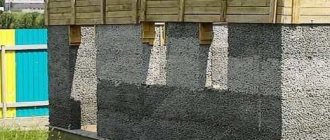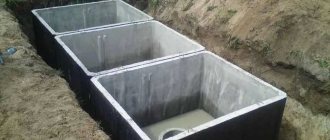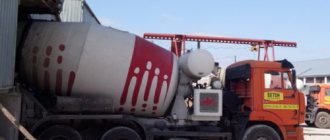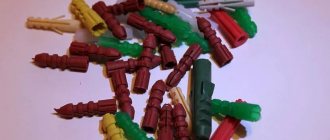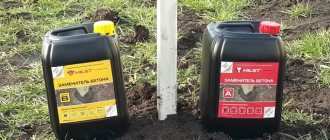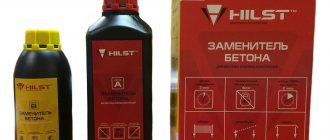The building materials in demand: concrete and Portland cement-based mortar, have a significant drawback. When setting and gaining strength in the open air, the poured structure shrinks 1-1.5 mm/m. During the construction of extended and volumetric structures (tanks, reinforced concrete products, mine shafts, etc.), concrete shrinkage causes cracks and even structural failure.
Therefore, for these purposes, a special building material is used - self-expanding cement. The concept of “expanding cement” unites a group of “binders” that have one feature - the ability to expand in volume within the range: 0.15-0.7%.
Features of concrete hardening using self-expanding cement
The self-expansion effect is achieved through the creation of Ettringite minerals. The formation of Ettringite crystals occurs through the interaction of additives - aluminates and water-based calcium sulfates. At the same time, the mineral crystals contain a large number of H2O molecules.
It is this circumstance that provides the self-expansion effect. The solid components of self-expanding cement, interacting with each other during the process of hydration, add water to themselves and thus increase their volume by several orders of magnitude.
One of the main features that characterize this type of binder is that in solutions based on it, two processes occur in parallel: the process of formation of ettringite, which ensures an increase in volume, and the process of setting and hardening. If the process of mineral formation occurs earlier than the process of setting and gaining low strength, the self-expansion effect will not work. Ettringite crystals will “compress” the pliable mass in the opposite direction.
Therefore, when constructing structures made of self-expanding cement, it is necessary to ensure constant moistening of the surface for from 12 hours to 7 days, depending on the type of binder.
Volumetric deformations of structures
During the production of reinforced concrete, during the hydration of cement, colloidal and crystalline formations are formed, which can differently influence the deformation processes occurring in the cement stone.
The process of crack formation
During the hardening of mixtures, colloidal formations become denser and contribute to the appearance of shrinkage cavities. And the crystals formed, under certain temperature conditions at the time of hydration of the cement stone, can increase in volume, thereby provoking thermal expansion of concrete, leading to the appearance of cracks on the surface of structures.
Shrinkage deformations
According to the mechanism of occurrence, shrinkage is divided into two types.
This:
- shrinkage stress (expansion)
- shrinkage deformation.
The intensity of such deformations depends on humidity and ambient temperature.
Shrinkage deformations
Changes occurring as a result of shrinkage deformation, combined with the phenomenon of linear expansion of concrete, significantly reduce the crack resistance and durability of structures. The fundamental principle of shrinkage is the process of reducing the linear dimensions of the mixture that occurs over a period of time, caused by physical and chemical reactions occurring at that time in the structure of the product.
Graph of changes in shrinkage over time
Shrinkage processes can be divided into several stages:
- plastic deformation occurring at the moment of setting of the mixture;
- shrinkage caused by subsequent hardening of the mixtures (up to 28 days);
- deformations that occur in adulthood (more than 28 days).
The shrinkage coefficient is a conditional percentage change in the initial volume of the material compared to its final value, and usually does not exceed 1.5%.
Linear temperature deformation
Linear extensions
Linear expansion is volumetric transformations that occur in the structure of a material under the influence of internal or external temperature factors.
- Linear expansion coefficient of reinforced concrete (α). This is a relative increase in the linear dimensions of structures with an increase in temperature by 1 K under standard conditions.
- Coefficient of thermal expansion of concrete. Its value depends on the temperature and relative humidity of the environment. This parameter is inextricably linked with the thermal conductivity of the material.
Note: The last value represents the product’s ability to accumulate or conduct heat through its structure. The higher the density, the higher this parameter.
- Coefficient of linear expansion of concrete. Equal to 0.00001 (°C)-1 - that is, when the temperature rises to +50°C, the linear expansion will have a value of 0.5 mm/m.
- Expansion coefficient of concrete. It also depends on the brand of cement and the composition of aggregates.
Aggregate and cement stone have different coefficients of thermal expansion. Therefore, when temperature conditions change, these components behave differently, resulting in volumetric stresses in the structure of the product, which contribute to the formation of cracks both on the surface and inside the material.
To prevent cracking, thermal expansion and shrinkage deformations in modern construction, a whole range of measures is provided:
- expansion joints in concrete (expansion or temperature);
- increasing the frequency of reinforcement of structures;
- division of monolithic surfaces into separate autonomous blocks, etc.
Expansion joint
However, all these methods significantly increase the cost of construction and are not always effective in improving performance characteristics. The most effective way to eliminate the above-described disadvantages is to use expanding and tension binders.
Types and purpose
At this point in time, the construction industry and individuals can purchase the following types of expanding products for the preparation of concrete and mortars:
- Waterproof Expanding Cement (WEC). This type of binder is created by grinding the components together or mixing ready-made aluminous cement, natural gypsum and an additive - calcium aluminate. The beginning of setting of materials based on VRC occurs within four minutes. Finish setting within 10 minutes. To increase the setting period, additives are added to mortars and concretes: borax, acetic acid or SDB. Scope of application: repair of structures, waterproofing of underground structures, creation of waterproof joints.
- Gypsum-alumina cement (GC). A popular fast-hardening cement, a product of joint grinding or mixing of aluminous clinker and special natural gypsum. Scope of application: waterproofing underground structures, caulking joints, preparing expanding concrete and mortars.
- Self-expanding quick-setting cement RPTs 500 or RPTs 400. The composition of this type of binder includes Portland cement clinker, aluminous clinker and additives. Scope of application: repair and restoration work, waterproofing of structures, embedding joints of hydraulic structures.
- Self-expanding cement NC. When mixing, it first gains strength and then self-expands. This makes it possible to strain the structure being built. The composition of NC can be characterized as special: ordinary general construction Portland cement, aluminous cement and gypsum. Scope of application: production of pipes working under division, construction of tanks, construction of sports facilities.
Concrete substitute - what is it?
Concrete mortars, both prepared locally from the original ingredients and sold in the form of dry construction mixtures based on cement, have been and remain at the peak of demand. All this is due to the expressed advantages, which include relatively affordable cost, simplicity and clarity of use, high reliability, provided that all technological requirements are met during preparation, pouring and during the maturation period. It would seem, what more could you want?
However, let's remember that working with concrete also has many disadvantages:
- All components of concrete, that is, cement, sand, and crushed stone (gravel), have a significantly high specific gravity. All this requires considerable material costs and physical effort during loading, unloading and transportation.
- To mix concrete solution, especially if a large amount is required, special equipment is needed. And when ordering a ready-made one, you have to pay for the work of special vehicles.
- You can work with ordinary concrete mortar only at positive temperatures. There are technologies using special additives, but this is more complicated, more expensive, and often also a certain loss of quality.
Is it possible to work with concrete in cold weather?
To be honest, this should be avoided whenever possible. But in some regions there is simply no other way to complete construction on time. So we have to use winter concrete pouring technologies , which are described in a special publication on our portal.
- Concrete takes a long time to harden, so construction sometimes drags on for months. There is no escape - for high-quality ripening with the ability to apply design loads, at least four weeks are required.
- Whether you produce concrete yourself or order it ready-made, the area around the construction site is inevitably polluted.
All these difficulties can be avoided if you use one of the existing concrete substitutes. This is a composite material, usually sold as a two-component composition.
Today, on the Russian construction market, this innovative material is presented in four versions: one foreign - “FAST 2k” (Canada), and three domestic - “HILST”, “GPN-100” and “Betonit”.
In order to understand the characteristics of the proposed options and choose the most suitable one for the job, it is necessary to consider the features of each of them.
Technology of working with material
Using the composition is not difficult even for beginners. The work is done in this way:
- dig holes of the required size (slightly larger than the diameter of the support),
- prepare the components of the solution, open the packages (if it is frosty outside, they must first be kept for 2 hours at room temperature or heated to +25 degrees directly at the place of work),
- combine the ingredients according to the instructions in a clean plastic container, beat them with a drill with a mixing attachment for 45 seconds, no more,
- at one time it is worth preparing no more than 4 liters of solution, which is enough for 8 medium-sized holes,
- install the column in the hole, align it vertically, fill it with solution,
- after 4-5 minutes the product will increase in volume like polyurethane foam,
- if necessary, remove excess composite or add it,
- after 5 minutes you can stop holding the support, and after 2-3 hours you can start using it.
If the product is sold in a single-component form, it does not need to be mixed, but can be poured into the wells directly from the package. Polymerization will occur due to contact with air. On average, a package weighing 1100 g replaces 50 kg of dry cement.
Brands and characteristics of non-shrink cement
Table 1 - The most popular brands of cement
| Brand | View | Additive content, % | Characteristic |
| M 400 | VBC | D 0 | One of the most widely used cements, it is durable, impervious to moisture, and hardens quickly. It is sealed, durable, corrosion resistant and reliable. |
| D 20 | |||
| VBC B | D 0 | ||
| D 20 | |||
| M 500 | VBC | D 0 | |
| D 20 | |||
| VBC B | D 0 | ||
| D 20 | |||
| M 600 | VBC | D 0 | |
| D 20 | |||
| VBC B | D 0 | ||
| D 20 |
- M 400, 500, 600 - this is the marking of cement, it means the strength of the finished material, measured in kg per square meter. cm.
- VBC – waterproof non-shrinking cement, B – quick-drying.
- D – characterizes the content of additives in the cement composition, which affect the characteristics of the product. D0 means that there are none, D20 means that 20% of the product was replaced with additives.
Application area
The composite is used where pouring traditional concrete solutions is difficult. It is usually used in hard-to-reach areas, in mountains, forest areas, although it is suitable for absolutely any climatic conditions. Most often, supporting structures and individual elements (horizontal and vertical) are prepared using concrete substitutes. The material is used for fastening, repair, installation, restoration:
- fencing made of wood, metal, concrete, brick,
- columns, gazebos, lanterns, terraces,
- children's playgrounds and attractions,
- road structures - signs, indicators, barriers,
- parking,
- water and gas supply lines,
- masts, flagpoles.
Expansion joint in screed
Layout of different types of screed seams.
The pattern of cuts used to separate the screed depends on the area and configuration of the room. Wall seams are deep to the entire height of the screed. They are filled with elastic gaskets up to 10 mm thick, silicone. Also, fill slabs are cut at the level of doorways and corridors, but not to the full height of the material. Likewise, it must be separated from the flight of stairs.
If the area of the room is more than 30 m2 or if it has L-shaped areas, it is fragmented into rectangular (square) components with a side no longer than 6 meters. Columns installed in the room are also separated by cuts (in the shape of a square) at their base. When the screed contains reinforcement, cutting is done along the boundaries of the reinforcement cage sheets.
In the middle of the monolith, the cuts are usually tied, for example, to the dimensions of the tiles laid on the floor (the seam must pass between them). In heated floors, the screed is cut along the boundaries of the fields of the heat-generating elements. The cutting depth is determined by its height, and it also depends on the presence of heating pipes in the floor. In such cases, the concrete mass is cut by 1/3 - 1/2 of its thickness.
Return to contents
Purpose of non-shrinkable concrete
The type and grade of concrete must be selected in accordance with the purpose of the construction project and the conditions in which it will be used. According to GOST, non-shrinkable concrete can be used for bridges and reinforced concrete structures, road surfaces, and hydraulic structures.
The main objective of non-shrinkage concrete is to reduce shrinkage and quickly gain strength, which is most often used in repairs and construction. An important property of such concrete is rheoplasticity (mobility of the product) - this makes it easy to lay cement, while creating a high density for the finished material.
Relevance of use
To achieve a stable position of the pillars when installing the fence, they have to be buried in the ground and filled with concrete. For this purpose, a hole is dug, a pillar is placed, after which the gap is filled with liquid concrete (cement-sand) mass. This solution hardens quite quickly and securely anchors the posts in the soil. However, the cement mixture gains its final strength only after a month, and during this period the final installation of the fence cannot be carried out.
Concrete mixtures are difficult to prepare. The work site becomes very dirty, and it is better to mix cement and sand in a concrete mixer. It is possible to make only a small portion by hand, but mixing it thoroughly is still problematic. Concrete substitutes are rapidly replacing traditional mortars for the following reasons:
- the area is kept clean,
- the finished mixture starts without much effort,
- the stability of the supports will be higher.
Advantages and disadvantages of composite material
Using composites is much more profitable and effective than concrete, since they have a number of advantages:
- Speed. When using substitutes, the total time required to complete all work is reduced by 80%. After pouring, the product becomes durable in just 5 minutes; finished structures can be used in a couple of hours.
- Purity. There will be no need to do “general” cleaning on the site, which is especially important for forest areas, parks, and recreation areas.
- Low labor intensity. To fill, you do not need to hire a team of workers, and the simplicity of the process allows you to do it yourself. It is almost impossible to change the proportions of the components - everything is already measured and packaged in convenient packages.
- Strength. After polymerization, mixtures based on composites become much more resistant to damaging factors than concrete solutions.
- Environmental friendliness. The compositions do not contain harmful components; they are completely safe for people and the environment. In addition, composites do not damage metal or wood, and do not cause rotting or corrosion.
Concrete substitutes can be used even at sub-zero temperatures (down to –25 degrees), which can be important under certain climatic conditions in the region. The only disadvantage worth mentioning is the higher price than cement, but it is compensated by savings on labor costs and payment for the work of a team of hired builders. High temperatures negatively affect the strength of the solution, so overheating during its manufacture must be avoided.



